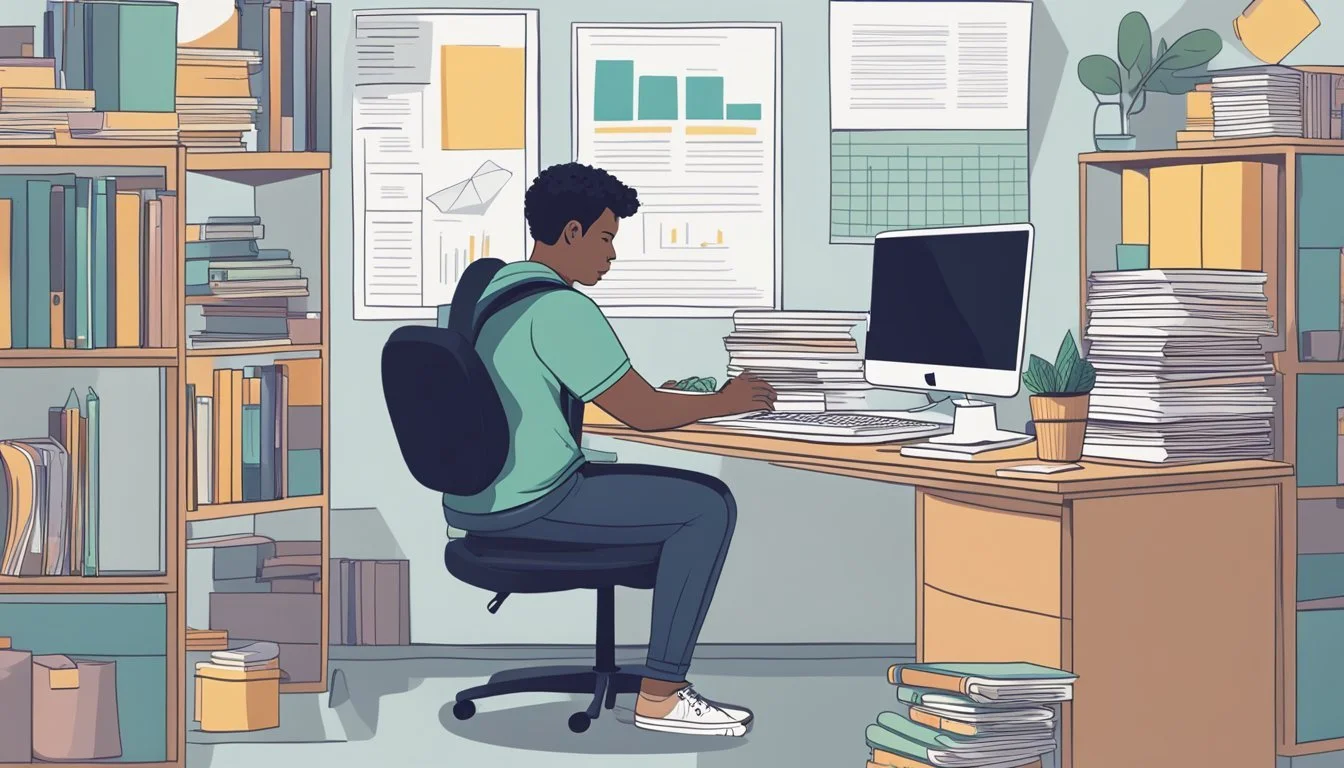11 Tips for Managing PTSD Symptoms in College
Effective Strategies for Students
Managing PTSD symptoms while navigating the challenges of college life can be daunting. Students with PTSD often face unique stressors that can affect their academic performance and personal well-being. Understanding how to manage these symptoms effectively can make a significant difference in a student's college experience.
Creating a supportive environment and utilizing effective strategies are crucial for students coping with PTSD. This article provides actionable tips designed to help college students manage their PTSD symptoms, ensuring that they can thrive both academically and personally.
1) Develop a Routine
Establishing a consistent daily routine can provide structure for those managing PTSD in college. Predictable schedules can help reduce anxiety and create a sense of stability.
Start by setting specific times for waking up, attending classes, studying, and relaxing. This approach can make daily activities more manageable and lessen the feeling of being overwhelmed.
Regular exercise and meal times should also be incorporated into the routine. Physical activity has been shown to reduce stress, while balanced nutrition supports overall health and well-being.
Additionally, allocate time for relaxation techniques such as meditation or deep breathing exercises. These practices can help calm the mind and reduce the impact of stressors.
By maintaining a well-organized schedule, students can better focus on their academic and personal growth, while also effectively managing their PTSD symptoms.
2) Join a Support Group
Support groups provide a sense of community for individuals dealing with similar issues. In college, finding a mental health support group can be invaluable. These groups offer a safe space to share experiences and learn coping strategies.
Many universities have on-campus support groups for students experiencing PTSD. Participation in these groups allows individuals to feel less isolated and more understood. The group dynamic encourages openness and sharing.
Online resources also offer support, particularly if on-campus options are limited. Websites like Mind Diagnostics list both in-person and virtual groups. By joining these forums, students can connect with others no matter their location.
Veterans can find targeted support through specialized groups offered by the VA National Center for PTSD. These groups cater specifically to the unique experiences of combat veterans. Family members can also receive support via the VA Caregiver Support Line.
Utilizing support groups fosters a sense of belonging and shared experience. Sharing with peers who understand helps alleviate the burden of PTSD symptoms in the challenging college environment. It’s an effective step toward managing mental health alongside academic responsibilities.
3) Practice Mindfulness
Mindfulness can significantly help manage PTSD symptoms in college students. This practice involves paying full attention to the present moment without judgment. It helps in reducing stress, anxiety, and depressive symptoms, which are common among students.
Mindfulness-based interventions have shown effectiveness in decreasing PTSD symptoms. Greater trait mindfulness is associated with reduced PTSD symptoms and lower rates of PTSD. Regular practice can enhance overall mental health.
Simple mindfulness exercises can be integrated into daily routines. For instance, paying attention to one's breath for a few minutes or practicing mindful walking around the campus can ground students in the present moment.
Mindful breathing, deep breaths in and out, can be especially helpful during moments of heightened stress or anxiety. It is crucial to approach mindfulness consistently for it to be beneficial.
Instructors can also facilitate mindfulness exercises in classrooms, creating a supportive environment for students dealing with trauma. Trauma-informed mindfulness teaching emphasizes safety, consent, and personal choice, acknowledging potential PTSD triggers.
By practicing mindfulness regularly, college students can cultivate a greater sense of calm and resilience. This practice empowers them to handle stressors more effectively, improving both academic performance and emotional well-being.
Incorporating mindfulness into daily life doesn't require substantial time or resources, making it an accessible tool for everyone.
4) Utilize Campus Counseling Services
College campuses often provide counseling services specifically for students. These services can be a vital resource for those managing PTSD symptoms. Students can access trained professionals who understand the unique challenges they face.
Counseling centers typically offer individual therapy sessions. These sessions allow students to discuss their experiences and symptoms in a safe, confidential environment. Therapy can help in developing coping strategies tailored to individual needs.
Many campus counseling services also offer group therapy. Group therapy sessions provide a space for students to share their challenges and support each other. Engaging with peers who may face similar issues can foster a sense of community and reduce feelings of isolation.
In addition to therapy, counseling services often provide workshops and seminars. These can cover topics like stress management, personal wellness, and specific PTSD coping techniques. Attending these can provide students with practical tools to manage their symptoms.
Students are encouraged to take advantage of these resources early. Engaging with counseling services sooner rather than later can help prevent symptoms from worsening. It also helps in building a strong support network on campus.
For more information, students can visit their campus counseling center website or office. Often, these services are included in tuition fees, making them accessible without extra cost. Taking the step to utilize these resources can significantly impact a student’s well-being and academic success.
5) Create a Safe Space
Creating a safe space is essential for managing PTSD symptoms in college. It's important to have an environment where one feels secure and at peace.
One approach is to personalize your living area with comforting items such as favorite photos, soft blankets, or calming scents. These elements can help promote a sense of safety and relaxation.
Another method involves establishing "liminal spaces" in classrooms. These are places designed to offer a sense of transition and safety, allowing students with PTSD to step away and regain their composure when necessary. This concept can be highly effective in educational settings.
Routine and structure can also provide a sense of predictability and control. Setting up a regular schedule that includes time for relaxation can be very beneficial.
Additionally, having access to supportive friends or pets can create a significant sense of comfort. The presence of compassionate individuals or calming animals can make a substantial difference.
For more strategies on creating safe spaces, the article on creating a trauma-informed classroom provides useful insights. Implementing these small changes can make a big impact on mental well-being.
6) Limit Exposure to Triggers
Students with PTSD can benefit greatly by limiting exposure to known triggers. Identifying these triggers is the first critical step. Once they are known, strategies can be devised to minimize contact with them.
For instance, if certain environments or situations provoke anxiety, avoiding them as much as possible can help manage symptoms. This might mean altering routes taken on campus or limiting visits to crowded places.
In some cases, technology can be a useful aid. Using apps designed to manage PTSD symptoms or setting up reminders to practice calming techniques can provide additional support.
It's also beneficial to inform close friends or roommates about specific triggers. This way, they can help ensure a safer, more comfortable environment.
Adjusting social activities or schedules can make a significant difference. For example, choosing quieter, less populated study spaces can reduce stress levels.
By consistently avoiding or minimizing exposure to triggers, students can create a more manageable and supportive daily routine, fostering a better academic and personal experience.
7) Stay Physically Active
Regular physical activity plays a crucial role in managing PTSD symptoms. It helps reduce anxiety and improve mood. Exercise stimulates the production of endorphins, which are natural mood lifters.
Incorporating activities like jogging, swimming, or even walking can make a significant difference. Even moderate physical activity can have positive effects on mental well-being.
Maintaining a routine is key. Consistency in physical activity helps in building resilience and managing stress. It's important to find an activity that is enjoyable to ensure ongoing participation.
Joining fitness classes or sports teams can also provide a social component. Group activities offer additional support and encouragement from peers.
Staying active can improve sleep patterns. Quality sleep is essential for mental health and overall functioning. Exercise can help regulate the sleep-wake cycle.
Lastly, combining physical activity with mindfulness practices, such as yoga or tai chi, can enhance the benefits. These activities focus on both physical and mental health, promoting a holistic approach to managing PTSD symptoms.
8) Engage in Creative Activities
Creative activities offer a valuable outlet for processing emotions related to PTSD. By engaging in activities such as painting, writing, or playing music, individuals can express themselves in a non-verbal way. This can be particularly beneficial for those who find it difficult to articulate their feelings through traditional means.
Art therapy has been shown to help individuals with PTSD by providing a sense of control and a way to explore and work through traumatic experiences. Additionally, creative pursuits can serve as a distraction, helping to reduce anxiety and other distressing symptoms.
Writing, whether through journaling or composing poetry, allows a person to organize their thoughts and reflect on their experiences. Music, on the other hand, can be both soothing and invigorating, offering a way to process and regulate emotions.
Students dealing with PTSD may find that incorporating creative activities into their routine provides a therapeutic way to cope with their symptoms. This approach to self-expression can promote healing and emotional well-being, making it easier to navigate the challenges of college life.
For more detailed insights on the benefits of creative expression for PTSD, exploring the information provided in The Ultimate Guide: 8 Self-care Techniques to Manage PTSD can offer additional guidance.
9) Establish Healthy Sleep Patterns
Establishing healthy sleep patterns is crucial for managing PTSD symptoms in college. Maintaining a regular bedtime can help regulate the body's internal clock. Creating a relaxing bedtime routine, such as reading or listening to calming music, can signal the body that it's time to wind down.
A cool, dark, and quiet sleep environment is recommended. Limiting screen time before bed reduces exposure to blue light, which can interfere with the production of melatonin, the hormone that regulates sleep.
Reserving the bedroom for sleep and intimate activities only can help mentally associate the space with rest. Avoiding caffeine and large meals close to bedtime can prevent disruptions in sleep.
Engaging in regular physical activity during the day can improve sleep quality. However, it's best to avoid vigorous exercise close to bedtime.
Incorporating elements of proper sleep hygiene can significantly reduce sleep problems associated with PTSD.
For individuals in college, balancing academic and social activities while prioritizing sleep is essential. Healthy sleep patterns can serve as a protective factor against anxiety and depression, promoting better overall mental health.
10) Build a Strong Support Network
Having a strong support network is crucial for managing PTSD symptoms in college. Supportive relationships can provide emotional stability and practical help. They can also offer a sense of community and belonging, which can mitigate feelings of isolation.
Engaging with peer support programs can be beneficial. These programs offer a safe space to share experiences and feelings with others who understand similar pressures. They can foster a sense of camaraderie and reduce stigma.
Family and friends often play a key role. Talking about experiences and feelings with trusted individuals can provide comfort. They can also help identify signs of distress and offer encouragement.
Therapists and counselors are invaluable resources. Regular sessions can help in processing traumatic events and developing coping strategies. They can also provide a professional perspective and tools to better manage symptoms.
On-campus support groups are another option. Joining these groups can help connect with others facing similar challenges. They provide a platform for sharing strategies and receiving peer encouragement.
Using online forums and communities can offer additional support. These platforms allow for anonymous sharing and can offer advice and understanding from a wider network. They can be particularly useful for those who might not have access to local resources.
Connecting with mentors or academic advisors can also help. They can provide guidance on balancing academic responsibilities with personal well-being. They can also offer accommodations if symptoms affect academic performance.
A strong support network is fundamental in navigating the complexities of PTSD while managing college life.
11) Focus on Nutrition
For students managing PTSD, diet can have a significant impact. A balanced diet supports mental health and energy levels. Opt for whole foods such as fruits, vegetables, lean proteins, and whole grains.
Avoid highly processed foods like chips and ice cream. Although they can provide temporary comfort, these choices often lead to spikes and crashes in blood sugar. Frequent consumption of such foods may worsen mood swings and anxiety.
Incorporating high-fiber foods can be beneficial. Research indicates that fiber-rich foods may reduce the risk of PTSD. Including items such as oats, beans, and berries can help stabilize blood sugar levels and improve overall gut health.
Those with PTSD often experience poor eating habits. Making a conscious effort to eat regular, nutritious meals can help mitigate some symptoms. Staying hydrated is equally important, as dehydration can affect mood and concentration.
Vitamins and minerals also play a key role. Ensure adequate intake of nutrients like omega-3 fatty acids, found in fish, flaxseeds, and walnuts. These nutrients are linked to improved brain function.
Lastly, seeking guidance from a nutritionist can provide personalized advice. They can help create a meal plan tailored to individual needs, promoting better health and symptom management.
Understanding PTSD in College
PTSD in college students often arises due to triggers in academic settings and has a significant impact on their daily lives and academic performance.
Common Triggers in Academic Settings
Academic settings can be a hotbed for PTSD triggers. Exams can cause overwhelming anxiety, especially for those with trauma related to performance pressure. Class presentations can trigger distress, particularly if the trauma involved public humiliation or scrutiny. Crowded lecture halls can induce panic, often linked to past experiences in chaotic or unsafe environments.
Instructors' reactions and classroom dynamics can also contribute. A stern reprimand may remind one of past abuses, and group discussions can evoke memories of traumatic social interactions. Understanding these triggers helps in creating a supportive environment for affected students.
How PTSD Affects College Life
PTSD can severely disrupt college life. Students may experience hypervigilance in crowded dorms or public spaces, leading to social withdrawal. Flashbacks and nightmares can disrupt sleep, causing daytime fatigue and impaired concentration, directly affecting academic performance.
Many students struggle with trust issues, making it difficult to form study groups or participate in extracurricular activities. This isolation can worsen feelings of hopelessness. Academic performance may suffer due to frequent absences, missed deadlines, and difficulty focusing during lectures. Addressing these impacts requires supportive measures from college staff and tailored mental health resources.
Effective Coping Strategies
For college students managing PTSD, specific techniques can provide significant relief. Key strategies include mindfulness and building a support system to help navigate daily challenges effectively.
Mindfulness and Meditation Techniques
Practicing mindfulness and meditation can greatly help in managing PTSD symptoms. These techniques involve staying present in the moment and acknowledging thoughts and feelings without judgment. Meditation, such as deep breathing exercises or guided imagery, can calm the mind and reduce anxiety.
Daily mindfulness practice, even for just a few minutes, can lower stress levels, improve concentration, and enhance emotional regulation. Students might find it beneficial to join a campus meditation group or utilize apps designed for mindfulness practice.
Building a Support System
Developing a robust support system is essential for college students coping with PTSD. This network can include friends, family, counselors, and support groups. Trusted individuals can provide emotional support and understanding, which is crucial during stressful times.
Connecting with campus resources, such as mental health services or peer support groups, can also be valuable. Encouraging students to communicate openly about their struggles can lead to stronger relationships and a more supportive environment. Participating in group therapy or counseling sessions can offer additional benefits.













